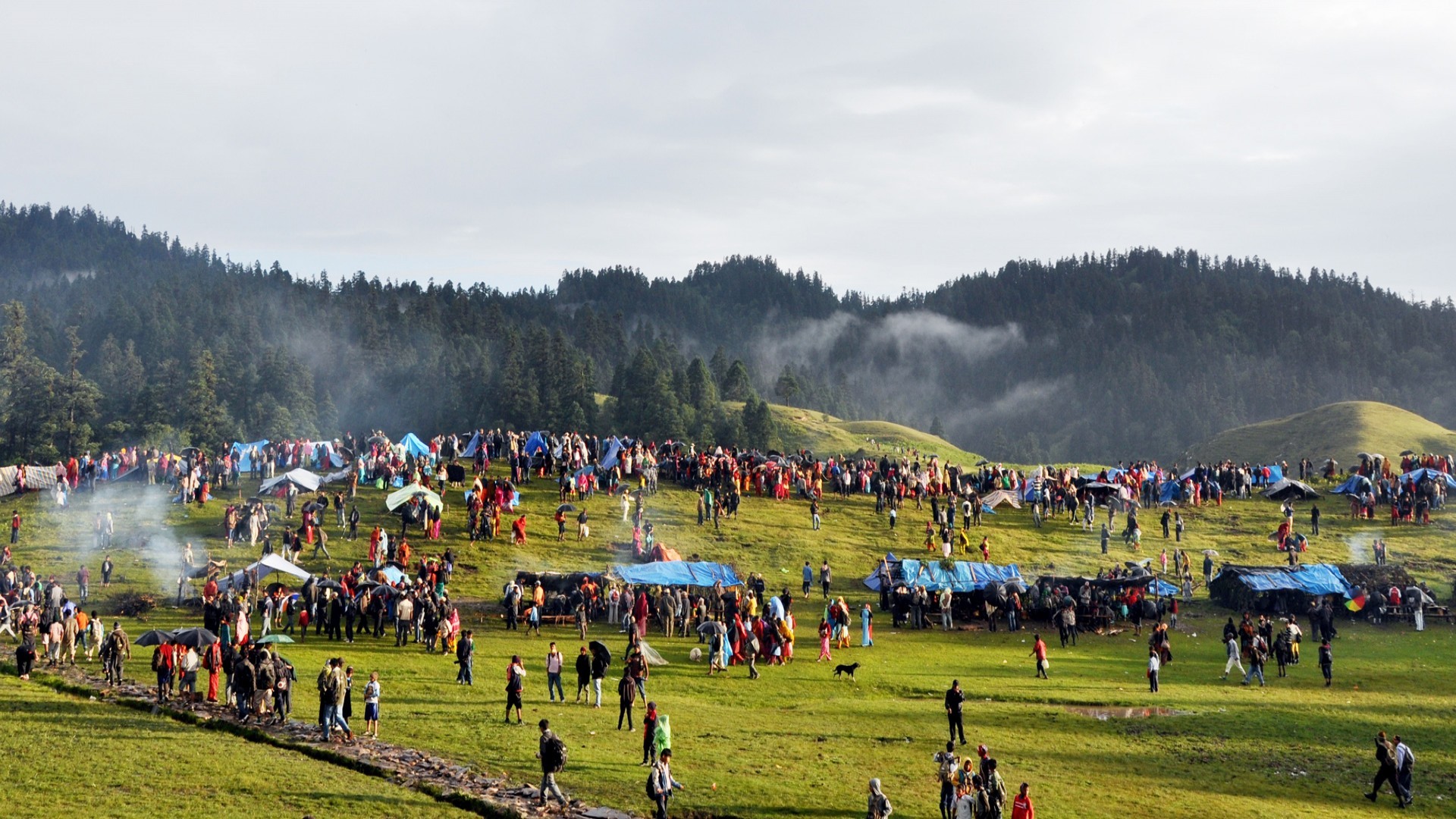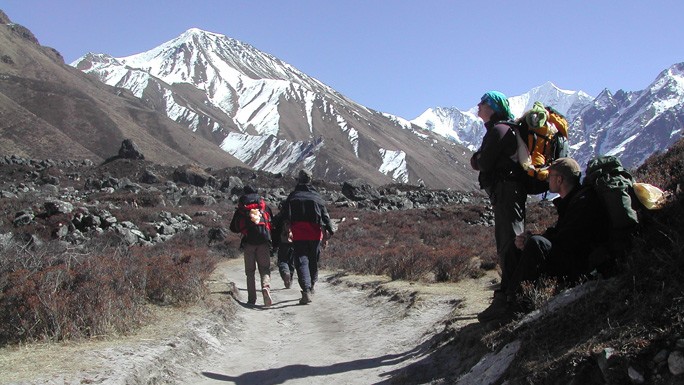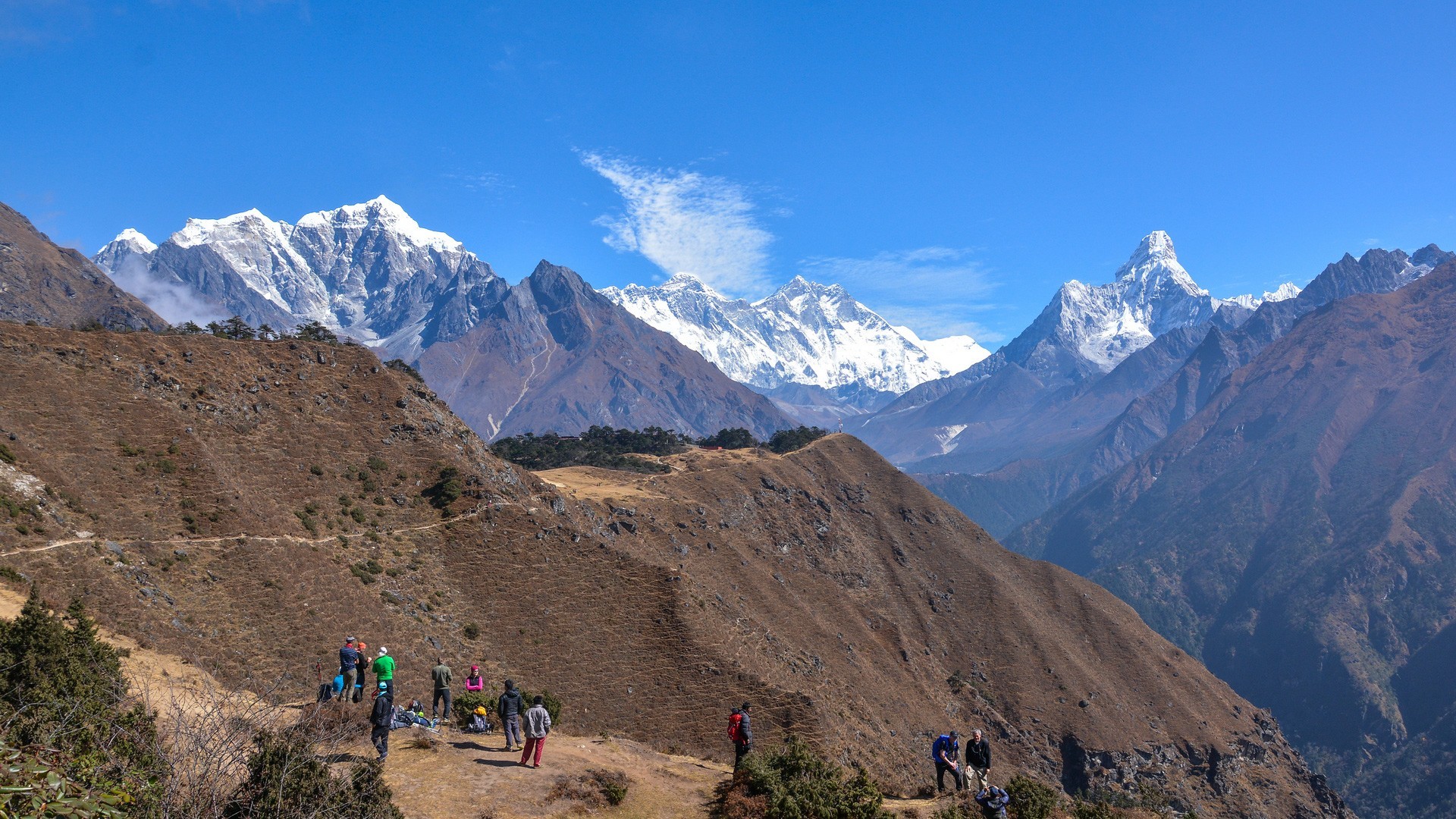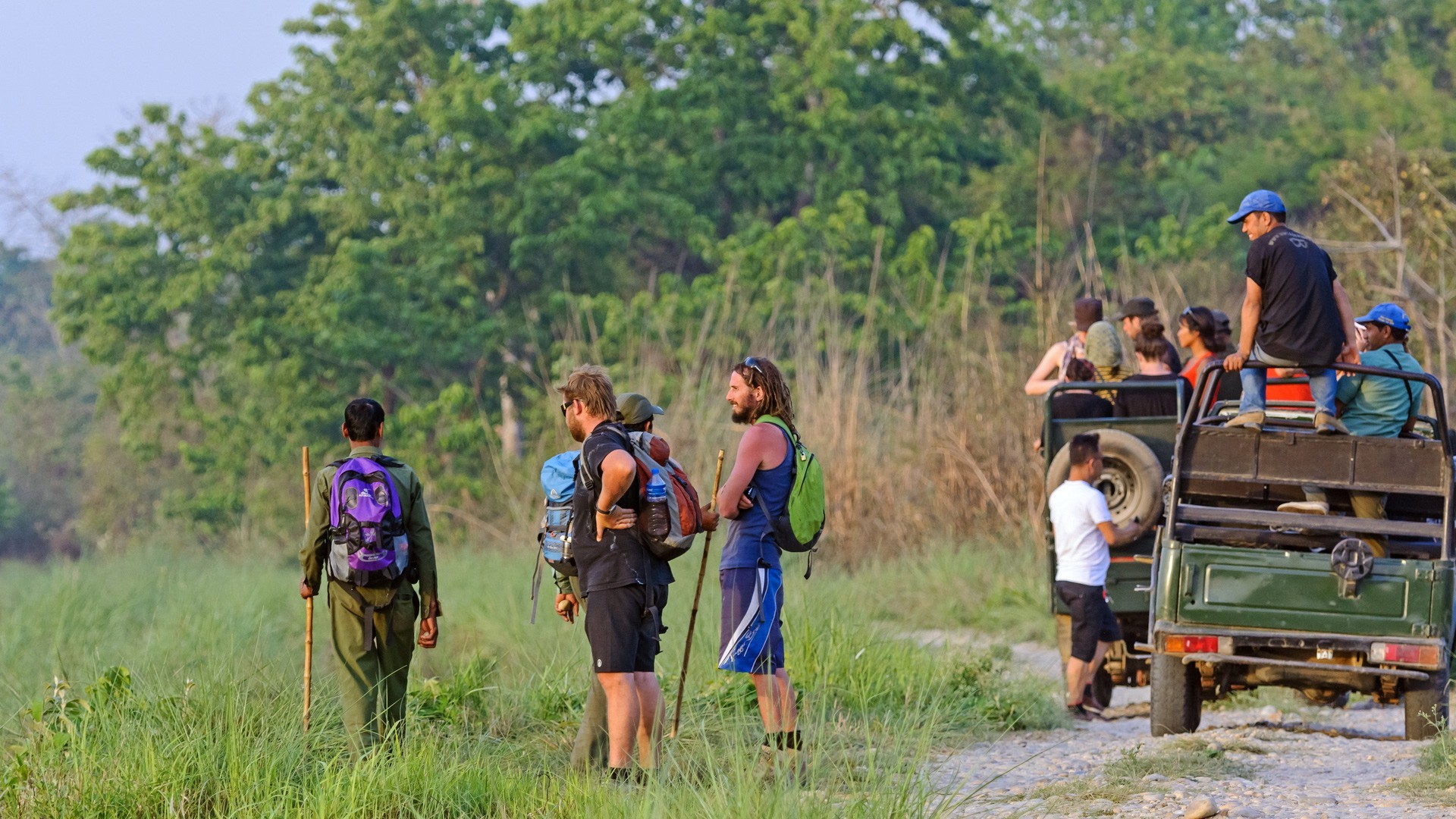-
Places to go
-
Things to do
-
Adventure
Nature
Culture
Wellness
Others
-
-
Festivals & Events
-
Festivals
Event Calendar
-
-
Plan Your Trip
-
Trip Ideas
Travel Details
Book Your Trip
-
- Travel Updates
National Parks Of Nepal
National Parks Of Nepal
National Parks Of Nepal
Discover Nepal through refreshing tropical and subtropical forests in the lap of Himalayas.
Trek through refreshing lush green tropical and subtropical forests to reach remote regions under arctic conditions in the lap of the Himalayas. Nepal is blessed with diverse landscape where within a distance of a hundred kilometers you can travel from the sweltering jungles of the tarai plains of the south to freezing temperatures in the Himalayan region in the north.
The jungles in the southern parts of Nepal are only a half-hour to an hour's flight away. The Chitwan National Park, Bardiya National Park, Parsa Wildlife Reserve and Shuklaphanta National Park are home to incredible varieties of mammals, reptiles and birds.
Chitwan National Park is recognized as the best conservation area in all of Asia with a fascinating range of wildlife roaming free in its jungles and grasslands. With their natural habitat well preserved, animals are thriving. Among these are the endangered species: the most sought after, Royal Bengal tiger and the Greater one-horned rhinoceros.
Koshi Tappu Wildlife Reserve in eastern Nepal, home to an astounding variety of bird species, is a birdwatcher's paradise. More than 800 species of birds are found in Nepal, many of which are migrants that arrive from as far as the UK and Siberia seeking warmer climes during winter, which is incidentally the best time to visit. Endangered species such as the Bengal florican are found here along with raptors, sunbirds, kingfishers and a wide variety of waterfowl. .
Khaptad National Park in the far west has a whole new topography with rolling hills amidst vast expanse of green pastures. Visit Sagarmatha National Park, Annapurna Conservation Area, Langtang National Park, Makalu Barun National Park, Kanchenjunga Conservation Area, Rara National Park, and Shey Phoksundo National Park, some of the world's most fascinating trekking regions besides being the highest in altitude. Crossing 5000m passes are just part of your trekking itinerary and not a mountain climb. Hike up from lush green pastures to arid ice and snow covered base camps while enjoying spectacular mountain views along the way.
Follow jungle trails with experienced guides, who know the forest like the back of their hand. There’s always a bit of suspense as one never knows what will show up: a bear, a herd of deer, colourful peacocks,noisy monkeys on treetops, a pair of rhinos or maybe if you’re lucky, the elusive Royal Bengal tiger itself staring back at you.
The mountains are home to the Himalayan tahr and musk deer which may be spying on you from above, keeping a safe distance. If you are persistent and if luck is on your side, you could even spot the rarely seen snow leopard up in the crags.

Khaptad National Park
(225 km2) and Buffer Zone (216 km2)
Khaptad National Park in west Nepal is the home of Late Khaptad Swami, the renowned scholar and a hermit. The park with rolling hills of grasslands and forests of subtropical, temperate and sub alpine vegetation, is also a rich natural habitat. The park boasts of 224 species of medicinal herbs and offers excellent bird watching opportunities, with 270 species of birds, the common ones being different varieties of impheyan pheasant, partridges, flycatchers, bulbuls, cuckoos and eagles. Animals in the park are barking deer, wild boar, ghoral, Himalayan black bear, yellowthroated marten, rhesus monkey and langur monkey. The park also offers religious sightseeing at Tribeni on the way to its headquarters. There are several historical temples surrounding this area and an annual celebration of Ganga Dashhara is held here every Jestha Purnima. Another religious site is Sahashra Linga at 3,200 m, the highest point of the park. Other religious areas in the park include Ganesh Temple, Nagdhunga, and Kedardhunga. These areas are ideal places for meditation.Towards the northeast of the park is Khaptad Lake where a festival is held every August and September.
Activities: Trekking
Accommodation: Camping
Access: Fly from Kathmandu-Nepalgunj (60 min.), then fly to Chainpur (Bajhang) 20 min. and then a three-day walk; or fly Kathmandu-Dhangadi (1 hr. 10 min.) 670 km by drive, then 10 hrs. drive to silgadi and then 1 day trek
Best Season: Mar-May and Oct-Nov (10-20 degrees Celsius); Jun-Sep (rainy), Dec-Feb (snow)
Park Headquarter: Khaptad

Langtang National Park
(1710 km2) and Buffer Zone (420 km2)
The park extends over parts of Nuwakot, Rasuwa and Sindhupalchok districts in the mountainous terrain of Nepal-China (Tibet) border. The chief attraction of this park is the Langtang range in the north and several lakes in the south. High-altitude jungles with diverse vegetation and wildlife, scenic lakes, glaciers and Himalayan peaks combine to make Langtang an attractive destination for visitors. Twenty five percent of the park’s total area is covered by forest, starting at sub-tropical forests below 1,000 m giving way to alpine scrubs and grasslands toward higher altitude. Animals seen here are wild dog, red panda, pika, muntjac, musk deer, Himalayan black bear, Himalayan tahr, ghoral, serow, rhesus monkey, common langur, snow leopard among others. Out of 373 species of birds commonly seen birds here are tragopan and impeyan pheasants.
The Langtang Valley is also renowned for its holy Lake Gosainkunda. Thousands of Hindu pilgrims visit the lake area every year, especially during the Janai Purnima festival every August.
Langtang National Park Activities: Trekking,mountaineering, experience of Tamang culture
Accommodation: Lodges, camping Access: From Dhunche which is 117 km by road from Kathmandu
Best Season: Oct-Nov and Mar-May (cold at higher elevation); Jun-Sep (monsoon), Dec-Feb (snow)
Park Headquarter: Dhunche

Sagarmatha National Park
(1,148 km2) and Buffer Zone (275 km2)
The prime attraction in the Sagarmatha National Park is Mt. Everest, the highest peak of the world. The park was added to the list of World Heritage Site in 1979. The park, a part of the Himalayan ecological zone, has several other prominent peaks most of which are above 6,000 m. With most of the park above 3,000 m, Sagarmatha is full of rugged terrain with deep gorges, glaciers and huge rocks. With its Himalayan terrain and its unique culture, the park offers a blend of natural and cultural tourist products here.The vegetation at lower elevation is dominated by pine and hemlock forests, while above 3,500 m the forest is dominated with silver fir, birch, rhododendron, and juniper trees. During spring and monsoon the varieties of rhododendron flowers are seen. The common wildlife in the park are Himalayan tahr, ghoral, musk deer, pikka (mouse hare) weasel, jackal. Other rarely seen animals are Himalayan black bear, wolf, lynx, and snow leopard. Birds inhabiting the park are of over 193 species. Common ones among them are the impeyan pheasant (Danphe), blood pheasant, red billed chough, yellow-billed chough, snow cock, snow pigeon, Himalayan griffon, and lammergeyer. The national park also showcases the cultural trophies with the warm Sherpa hospitality and its many monasteries and cultural landmarks.
Activities: Trekking,mountaineering, experience of Sherpa culture Accommodation: Resort hotels, lodges, camping
Access: Fly to Lukla which is 30 minutes by air from Kathmandu
Best Season: Oct-Nov and Mar-May; Dec-Feb (snow, daytime temperature 5 degrees Celsius), Jun-Sep (rainy)
Park Headquarter: Mendalphu, Namche Bazaar, Tel: 038-626043

Chitwan National Park
(932 km2) and Buffer Zone (750 km2)
Owing to its rich adornment of nature, Chitwan National Park was declared UNESCO Natural Heritage Site in 1984. The park that includes in its area a part of the Shivalik Hills, is covered with deciduous forests overlooking the flood plains of Narayani, Rapti and Reu rivers and offering a wilderness of rich ecosystem that includes mammals, birds, reptiles and water animals of several kinds. There are around 600 plant species, 56 mammals, 539 birds and 49 amphibians and reptiles found in the park. The highlight are the 412 Asian onehorned rhinoceros and some 59 Royal Bengal tigers that live in the dense forests of the park. Sharing home with these are other animals like rhesus monkey, langur, deer, leopards, gaur, wild boar, wild dogs and wild cats. Among reptiles are different kinds of snakes including the python, while the river areas breed reptiles like the endangered long snouted gharial popularly known as Gangetic crocodile and marsh crocodiles. The forest is alive during summer with the arrival of migrant birds like paradise flycatcher, Indian pitta and parakeets, while winter birds include waterfowl, Brahminy ducks, pintails, bar-headed geese, cormorants and migratory birds from Siberia. Other bird varieties are woodpeckers, hornbills, peacocks, peahens, floricans and redheaded trogons.

Makalu Barun National Park
The park spreads over the districts of Sankhuwasabha and Solukhumbu in northeast Nepal. One of the prime attractions for visitors to the park is experience the unique Himalayan bio diversity. The vegetation ranges from sub tropical forests to sub alpine and alpine as the altitude increases. The park boasts of 48 species of orchids, 87 species of medicinal herbs, 25 of Nepal’s 30 varieties of rhododendron, 19 bamboo species, 15 oak species, 48 species of primrose and 86 species of fodder trees. The park also offers bird-watching opportunities with its 400 species of birds, including the rare spotted wren babbler and the olive ground warbler. Wildlife include the endangered red panda, snow leopard, Himalayan black bear, clouded leopard, ghoral, tahr, wild boar, barking deer, Himalayan marmot, weasel, langur monkey and serow. River Arun that flows through the park has 84 varieties of fish including salmon.
Activities: Trekking, mountaineering
Accommodation: Camping
Access: Fly to Tumlingtar from Kathmandu (40 mins.) and then a six-day walk
Best Season: Oct-Nov and Mar-Apr; Apr-May (hot at lower elevations), Jun-Sep (monsoon)
Park Headquarter: Seduwa, Tel: 029-560136

Shey-Phoksundo National Park
(3,555 km2) and Buffer Zone (1,349 km2)
Shey-Phoksundo National Park is situated in the trans-Himalayan region of north-west Nepal. It is Nepal’s largest national park.With diverse terrain and altitude variation, the park spreads over Dolpa and Mugu districts and supports a broad range of wildlife and vegetation. Geographical landmarks of the park are the Himalayan peaks in the north and Lake Phoksundo, in the southern region. Vegetation include pine, walnut, willow, oak, and cypress in the lower altitude and pine, spruce, juniper and birch at higher regions. Berberis, wild rose and caragana are seen in alpine areas while the regions higher up are mostly arid with grass alpine meadows with barely any trees. The park contains 286 flora species of botanical importance. Animals found in the region are sheep, ghoral, musk deer, leopard, wild dog, marmot, weasel, mouse hare, rhesus and langur monkeys, Himalayan tahr, Himalayan black bear and jackals. In the upper region is seen the rare and endangered snow leopard. Over 200 species of birds including yellow-throated marten, Tibetan partridge, wood snipe, white-throated tit, wood accentor, & crimson-eared rose finch are found in the park. Other species of birds found here are Impeyan, cheer pheasant, chough, ravens, Tibetan snow cock, Tibetan twit, brown dipper, Himalayan griffon & lammergeyer. Apart from these, the park is home to 6 species of reptiles and 29 species of butterfly.
Activities: Trekking, mountaineering
Accommodation: Camping
Access: Fly to Dolpa’s Jufal airport from Nepalgunj (20 min) and then a three-day walk Best Season: Mar-May and Sep-Oct
Park Headquarter: Sumduwa, Tel: 087-550104
Shivapuri Nagarjun National Park
(159 km2) National Park (159 sq km2)
Popular as trekking, hiking and recreation area, the Park offers the nearest retreat from Kathmandu. The park was established as a Watershed and Wildlife Reserve in 1976 and was declared as a national park in 2002 for the protection of its flora and fauna. Vegetation varieties in the park include its 129 species of mushrooms while animals include 19 species of mammals including Himalayan black bear, leopard, barking deer, wild boar, wildcat, rhesus monkey and langur monkey. The park also boasts of 177 species of birds and 102 species of butterflies.
Activities: Hiking, rock climbing, bird watching
Access: Drive from Kathmandu city centre to Budhanilkantha temple (11km), then trek. Best Season: Sep-May; Jun-Aug (rainy)
Park Headquarter: Shivapuri,Tel:01-4370355/ 4374830
Banke National Park
(550.00km2) and Buffer Zone (343.00km2)
BaNP located in Lumbini was established on 12th July 2010, it joins with Bardiya National Park towards west with a total area of 550.00 km.sq. Hotels can be found along the Southern border of the park. The core region of BaNP falls under Banke district along with Dang and Salyan in the north. Tiger, striped hyena, four- horned antelope are among the few animals protected in the park. Eight types of ecosystem can be found in the park such as, mixed hardwood forest, Sal forest, Bhabar and foothills of Chure range.
Access: One hour drive from Nepalganj to the park’s head office
Activities: Homestay, jungle safari
Best season: Early summer and autumn winter
Koshitappu Wildlife Reserve
(175 km2) and Buffer Zone (173 km2)
Koshi Tappu Wildlife Reserve has carved a place for itself as a bird watcher’s paradise. The reserve spreads over Saptari and Sunsari districts in East Nepal over the embankments of River Koshi. The reserve has been recognized as a Wetland Site from 1987. The vegetation of the reserve is mainly grassland with patches of scrub and deciduous riverine forests. The reserve has recorded around 479 species of bird variety, some of which fly all the way from Siberia during winter. A wide variety of ducks, herons, storks, egrets, ibis are seen on the riverbanks. Koshi Tappu wildlife Reserve also has one of the few elephant stables of Asia. Other animals found here are wild buffalo, wild boar, hog deer, spotted deer, blue bull and jackal. Gharial crocodile and Gangetic dolphin are also found here.
Activities: Game viewing, bird watching
Accommodation: Resorts, tented camp Access: 90-minute drive (40 km) from Biratnagar which is 50 minutes by air or 500 km by road from Kathmandu
Best Season: Oct-Mar; Apr-Jun (hot), Jul-Sep (rainy)
Reserve Headquarter: Kusaha, Tel: 025-530897
Parsa National Park
(499 km2) and Buffer Zone (298.2 km2)
The Parsa National Park spreads over parts of Chitwan, Makawanpur, Parsa and Bara districts. The vegetation is tropical and sub tropical mostly covered with Sal forests, while the hills are covered with chir pine. Khair, sissoo and silkcotton are found along water areas. The reserve provides good habitat for animals like wild elephant, tiger, leopard, sloth bear, gaur, blue bull and wild dog. Other common animals in the reserve are sambar, chital, hog deer, barking deer, langur monkey, rhesus macaques, striped hyena, rat, palm civet and jungle cat. There are 370 species of birds found in the reserve, one being the endangered great hornbill found in certain parts of the forest. Other bird species include peafowl, red jungle fowl, flycatchers and woodpeckers. Apart from birds and animals the reserve is also habitated by snakes like king cobra, common cobra, krait, rat snake and python.
Activities: Jungle safari on elephant-back, jungle walk, jeep drive
Access: Fly to Simara from Kathmandu (15 minutes) and then by road to the reserve headquarters (7 km), or overland from Kathmandu (150 km via Hetauda)
Best Season: Oct-Mar; Apr-Jun (hot, 30- 35 degrees Celsius), Jul-Sep (Monsoon) Reserve Headquarter: Adhabar,Tel:053-521051,520246
Shuklaphanta National Park
(305 km2) and Buffer Zone (243.5 km2)
Shuklaphanta National Park is located in the far-western lowland Terai of Nepal. The pristine sub-tropical jungle makes Shuklaphanta Nepal’s second largest wildlife reserve in Terai. The open grasslands and numerous waterholes of the park extend into a vast expanse of plain grasslands and Sal forests, while marsh vegetation is found along rivers and lakes. The reserve that was originally a hunting area was later converted to wildlife reserve to protect swamp deer. There serve now shelters almost 2,000 swamp deer, around 50 wild elephants and 30 tigers. Other animals found here are spotted deer, blue bulls, barking deer, hog deer, wild boars, leopards, jackals, langurs and rhesus monkeys. Among birds the reserve provides habitat to sarus crane, swamp francolin, grass owl, warblers, flycatchers, and the endangered Bengal florican. Reptile species include marsh mugger, crocodile, cobra and python.
Activities: Wildlife viewing on elephant-back
Accommodation: Jungle lodges
Access: Fly or drive (1 hr 10 min.) to Dhangadi (670 km from Kathmandu), than 1 hour 30 min. drive (60 km)
Best Season: Oct-Mar; Apr-Jun (hot, up to 42 degrees Celsius), Jul-Sep (rainy) Reserve Headquarter: Majhgaon, Kanchanpur, Tel: 099-521309
Dhorpatan Hunting Reserve
(1,325 km2)
Dhorpatan Hunting Reserve is the only area in Nepal where licensed hunting is allowed. The reserve adjoins Myagdi district and Baglung district, just below the Dhaulagiri range in West Nepal. The reserve begins at 3,000m and reaches as high as 7,000 m. Trees like fir, pine, birch, rhododendron, hemlock, oak, juniper and spruce are available in the reserve. One of the prime attractions for hunters is the blue sheep, which is abundant in the area. Hunters also get pheasants and partridges in viable numbers for hunting. Other animals found here are leopard, ghoral, serow, Himalayan tahr, Himalayan black bear, barking deer, wild boar, rhesus macaque, langur and mouse hare. Endangered animals in the reserve are musk deer, wolf, red panda, cheer pheasant and Danphe.
Activities: Trophy hunting, game viewing
Accommodation: Camping
Access: Four days’ walk from Baglung which is 72 km from Pokhara by road Best Season: Mar-Apr, Oct-Nov; Jul-Sep (monsoon), Dec-Feb (cold, windy, snow)
Reserve Headquarter: Dhorpatan, Tel: 068-521112
Annapurna Conservation Area
(7,629 km2)
The Annapurna Conservation Area is one of the best trekking trails in the world. The area spreads around Kaski, Mustang, Manang and Lamjung districts of Central Nepal. Starting with an altitude of 790 m, the area reaches as high as 8,091 m of Mt. Annapurna. Ghandruk is the first experience and further down is Ghorepani that provides fantastic panoramic view of the Annapurna ranges. Equally eye catching are hills of rhododendron that blossom every spring. The turning point of the Annapurna Circuit is Jomsom. The trek southeast from Jomsom, leads to the scenic Tilicho Lake area at an altitude of 4,919 m. In the circuit route, is the famous Hindu religious sites Muktinath Temple. The vegetation in this region includes various species of orchids and rhododendron. Wildlife includes 102 different kinds of mammals including rare endangered snow leopards and a very good population of blue sheep. The region also boasts of around 474 species of birds including multi-colored impheyan, koklas and blood pheasants. In addition the region is also home to 39 species of reptiles and 22 species of amphibians.
Activities: Trekking, mountaineering
Accommodation: Resort hotels, lodges, camping
Access: From Pokhara which is 202 km by road or 30 minutes by air from Kathmandu Best Season: March - May; Sep - Nov
ACAP Headquarter: Hariyo Kharka, Pokhara, Tel: 061-431102, 430802
Kanchenjunga Conservation Area
(2,035 km2 )
Kanchenjunga Conservation Area Situated in north-eastern Nepal in the district of Taplejung, the Kanchenjunga Conservation Area is bordered by the Tibet -China in the north, Sikkim-India in the east and Sankhuwasabha district in the west.The area has alpine grasslands, low river valleys with temperate and sub-tropical forests. Ten species among Nepal’s 20 indigenous gymnosperms and 15 among Nepal’s 23 endemic flowering plants are found in this region. In addition, almost 30 varieties of rhododendron species and 48 varieties of orchids are found here. Wildlife includes endangered snow leopard, Himalayan black bear, musk deer, red panda, blue sheep and rhesus monkey. About 252 species of different birds including impheyan pheasant, red-billed blue magpie, shy drongo are found in the area.
Activities: Trekking, mountaineering
Accommodation: Tea houses, camping
Access: Fly to Taplejung via Biratnagar from Kathmandu
Best Season: March-May; Sep - Nov
Park headquarter: Lelep, Tel: 024- 460081
New Conservation Areas
Api Nampa Conservation Area lies in the District of Darchula consisting of 21 Village Development Committees with an area of 1903 square kilometer . Snow leopard, musk deer and clouded leopard, Goral, Himalayan Black bear, Himalayan Tahr are found in the area .
Blackbuck Conservation Area also known as Krishnasaar lies in Bardia district covering an area of 15.95 sq. km. This is the first organized effort to conserve the already endangered Blackbuck (Antelope cervicapra cervicapra). Established in the year 2009 the population of blackbuck has now exceeded 200 in the conservation area.
Gaurishankar Conservation Area comprises of Sagarmatha National park and Buffer zone in the east and Langtang National Park and Buffer zone in the west, Tibet Autonomous Region of China in the north consisting of 2179 sq. km consisting of areas from three Districts - Ramechhap, Dolakha, Sindhupalchwok with Headquarter in Charikot.
Manaslu Conservation Area declared as a conservation area in 1998 by the government of Nepal covers a distance of 1663 sq.km. The altitude ranges from 600m to 8163m as the eight highest peak of the world Mt. Manaslu also falls in this region. The trek to the conservation area starts from Gorkha. About 19 types of forests alongside three main categories of vegetation such as, low hill, middle mountain, high mountain can be found in this area. About 33 species of mammals, 110 species of birds, 11 species of butterflies and 3 species of reptiles can be found in this region.
Nepal Tourism Board is a national tourism organization of Nepal established in 1998 by an Act of Parliament in the form of partnership between the Government of Nepal and private sector tourism industry to develop and market Nepal as an attractive tourist destination. The Board provides platform for vision-drawn leadership for Nepal’s tourism sector by integrating Government commitment with the dynamism of private sector.



